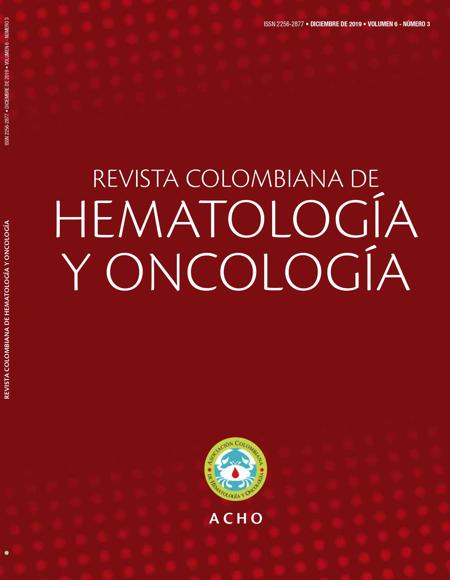Trombocitosis en tumores sólidos.
Thrombocytosis in solid tumors.

Cómo citar
Descargar cita

Esta obra está bajo una licencia internacional Creative Commons Atribución-NoComercial-CompartirIgual 4.0.
Mostrar biografía de los autores
Introducción: las plaquetas juegan un papel en invasión y cáncer. La trombocitosis se ha utilizado como marcador paraneoplásico de inflamación y pronóstico en tumores sólidos. Objetivo: determinar la relación entre trombocitosis (>450 mil cel/µl) con el estadio clínico, metástasis e histopatología en pacientes con tumores sólidos. Materiales y métodos: estudio transversal analítico, que incluyó 170 historias clínicas de pacientes no expuestos a quimioterapia al diagnóstico con tumores sólidos, describiendo características clínicas y la asociación de trombocitosis con estadio clínico, tipo histológico, grado de diferenciación, perfil molecular y metástasis. Los análisis se realizaron con regresión logística, Stata versión 12.0. Resultados: 76% femeninos, mediana de 63 años, mediana de plaquetas de 249.000 cel/µl. cáncer de mama en el 61,1%, próstata 12,3%, colon 15,8%, pulmón 5,88% y ovario 4,7%. Presencia de metástasis en el 37%, 23,5% con metástasis visceral, 13,5% con metástasis ósea y 4% del total de pacientes con metástasis viscerales y óseas. La trombocitosis se asoció con presencia de metástasis OR: 6,66 (IC: 1,29-34) p=0,023; entre las metástasis, se asoció la trombocitosis con compromiso visceral OR: 6 (IC 1,36- 26,3) p=0,018. No se encontró asociación de trombocitosis con tipo histológico, perfil molecular en cáncer de mama, escala de Gleason en cáncer de próstata, o con metástasis óseas. Conclusiones: el valor alto de plaquetas se asoció en este análisis con la presencia de enfermedad metastásica visceral. Se requiere ampliar la muestra con el fin de confirmar estos resultados, y realizar estudios que se relacionen con eficacia terapéutica.
Visitas del artículo 3899 | Visitas PDF 2704
Descargas
- Brewer DB, Schutze M, Bizzozero G. The discovery of the platelet, British Journal of Haematology. 2006;133:251-8.
- Izaguirre-Ávila R. El descubrimiento de las plaquetas. Historia de la Medicina Rev. Biomed.1997;8197-208.
- Burstein SA, Harker LA. Control of platelet production. Clin Haematol. 1983;12:3-22.
- Schafer A. Thombocytosis. N Engl J Med. 2004;350:1211-9.
- Álvarez JF, Bedoya-Trujillo N, Saldaña J. Enfoque clínico de la trombocitosis, una revisión de la literatura. Salutem Scientia Spiritus. 2018;4(1):41-48.
- Carrillo-Esper R, Garnica-Escamilla MA, Ramírez-Rosillo FJ, Trombocitosis. Rev Invest Med Sur Mex. 2013;20(4):254-6.
- Saavedra Ramírez G, Vásquez Duque GM, González Naranjo LA. Interleucina-6: ¿amiga o enemiga? bases para comprender su utilidad como objetivo terapéutico. Iatreia. 2011;24(2):157-66.
- Stone RL, Alpa MN, McNeish LA. Paraneoplastic thrombocytosis in ovarían cancer. N Engl J Med. 2012;366:610-8.
- Sarah ER, Obioha C. Clinical relevance of thrombocytosis in primary care. British Journal of General Practice. 2017;67(659):e405-13.
- Baileya SE, Ukoumunneb O, Sheparda E, Hamilton W. How useful is thrombocytosis in predicting an underlying cancer in primary care? A systematic review. Family Practice. 2017;34(1):4-105.
- Nash GF, Tornero LF, Scully MF, Kakkar A. Plaquetas y cáncer. Lancet Oncol. 2002;3:425-30.
- Ferlay J, Soerjomataram I, Dikshit R, Eser S, Mathers C, Rebelo M, Parkin DM, Forman D, Bray F. Cancer incidence and mortality worldwide: sources, methods and major patterns in Globocan 2012. Int J Cancer. 2015;136(5):359-86.
- Siegel RL, Miller KD, Jemal A. Estadísticas de cáncer, 2018. CA Cancer J Clin. 2018;68:7.
- Ferlay J, Soerjomataram I, Ervik M, Dikshit R, Eser S, Mathers C, et al. Globocan 2012, cancer incidence and mortality world wide. IARC Cancer Base. 2013;11:20.
- Gómez-Gómez B. Rodríguez-Weber FL, et al. Fisiología plaquetaria, agregometría. Med Int Méx. 2018;34(2):244-63.
- Miao-Zhen Qiu, Rui-Hua Xu, et al. Incidence of anemia, leukocytosis, and thrombocytosis in patients with solid tumors in China. Tumor biology. 2010;31(6):633-41.
- Tumor-platelet interaction in solid tumors. International Journal of Cancer. 2012;130(12):2747-60.
- Arrechea Irigoyen MA, et al. Molecular subtypes of breast cancer: prognostic implications and clinical and immunohistochemical characteristics. Anales Sis San Navarra. 2011;34(2).
- Blows FM, Driver KE, et al. Subtyping of breast cancer by immunohistochemistry to investigate a relationship between subtype and short and long term survival: a collaborative analysis of data for 10,159 cases from 12 studies. PLoS Med. 2010;7:e1000279.
- Huang W, Newman B, Millikan R. Risk of breast cancer according to the status of HER-2/neu oncogen amplification. Cancer Epidemiol Biomarkers Prev. 2000;9:65-71.
- Tsakountakis N, Sanidas E, Stathopoulos E. Correlation of breast cancer risk factors with HER2/NEU protein overexpression according to menopausal and estrogen receptor status. BMC Women Health. 2005;5:1-9.
- Kreike B, van Kouwenhove M, Horlings H, Weigelt B, Peterse H, Bartelink H. et al. Gene expression profiling and histopathological characterization of triple-negative/basal-like breast carcinomas. Breast Cancer Res. 2007;9:65.
- Wang YH, Deng SJ. Shao-jun Deng. The pretreatment thrombocytosis may predict prognosis of patients with colorectal cancer: a systematic review and meta-analysis. 2017;11(2).
- Fidler IJ. The patogénesis of cancer metastasis: the ‘seed and soil’ hypothesis revisited. Nat Rev Cancer. 2003;3(6):453-8.
- Anita R, Arpard S. Paraneoplastic thrombocytosis in breast cancer. Anticancer Research. 2013;33:4545-6.
- Benoy I, Salgado R, Colpaert C, Weytjens R, Vermeulen PB, Dirix LY. interleukin 6, plasma VEGF, serum VEGF, and platelet load in breast cancer patients. Clin Breast Cancer. 2002;2:311-5.
- Taucher S, Salat A, et. al. For the Austrian breast and colorectal cancer study: Impact of pretreatment thrombocytosis on survival in primary breast cancer. Thromb Haemost. 2003;89:1098-106.
- Kandemir EG, Mayadagli A, Karagoz B, Bilgi O, Turken O, Yaylaci M. Prognostic significance of thrombocytosis in node-negative colon cancer. J Int Med Res. 2005;33(2):228-35.
- Nyasavajjala SM, Runau F, Datta S, Annette H, Shaw AG, Lund JN. Is there a role for preoperative thrombocytosis in the treatment of colorectal cancer? Int J Surg. 2010;8:436-438.
- Ishizuka M, Nagata H, Takagi K, Iwasaki Y, Kubota K. Preoperative thrombocytosis is associated with survival after surgery for colorectal cancer. J Surg Oncol. 2012;106:887-91.
- Kandemir EG, Mayadagli A, Karagoz B, Bilgi O, Turken O, Yaylaci M. Significación pronóstica de la trombocitosis en el cáncer de colon con ganglios negativos. J Int Med Res. 2005;33:228-35.
- Qiu MZ, Yuan ZY, Luo HY, Ruan DY, Wang ZQ, Wang FH, Li YH, Xu RH. Impact of pretreatment hematologic profile on survival of colorectal cancer patients. Tumor Biol. 2010;31(4):255-60.
- Sasaki K, Kawai K, Tsuno NH, Sunami E, Kitayama J. Impact of preoperative thrombocytosis on the survival of patients with primary colorectal cancer. World J Surg. 2012;36:192-200.
- Maraz A, Furak J, Varga Z, Kahan Z, Tiszlavicz L, Hideghety K. La trombocitosis tiene un valor pronóstico negativo en el cáncer de pulmón. Anti Cáncer Res. 2013;33:1725-9.
- Crasta JA, Premlatha TS, Krishnan SM, Vallikad E, Rameshkumar K. Significance of preoperative thrombocytosis in epitelial ovarian cancer. Indian J Pathol Microbiol. 2010;53:546.
- Cohen JG, Tran AQ, Rimel BJ, Cass I, Walsh CS, Karlan BY, et al. Thrombocytosis at secondary cytoreduction for recurrent ovarian cancer predicts suboptimal resection and poor survival. Gynecol Oncol. 2014;132:5569.
- Gungor T, KanatPektas M, Sucak A, Mollamahmutoglu L. The role of thrombocytosis in prognostic evaluation of epitelial ovarian tumors. Arch Gynecol Obstet. 2009;279:536.
- Zeimet AG, Marth C, MüllerHolzner E, Daxenbichler G, Dapunt O. Significance of thrombocytosis in patients with epitelial ovarian cancer. Am J Obstet Gynecol. 1994;170:54954.
- Neal RD, Tharmanathan P, France B, et al. ¿El aumento del tiempo para el diagnóstico y tratamiento en el cáncer sintomático se asocia con resultados más pobres? Revisión sistemática. Br J Cancer. 2015;112(1):92-107.
- Kawano M, Mabuchi S, Matsumoto Y, Sasano T, Takahashi R, Kuroda H, et al. Prognostic significance of pretreatment thrombocytosis incervical cancer patients treated with definitive radiotherapy. Int J Gynecol Cancer 2015;25:165662.
- Humphrey PA. Cánceres de los órganos reproductores masculinos. En: informe sobre el cáncer en el mundo, Stewart BW, Wild CP, editors. Informe sobre el cáncer en el mundo. Lyon: Organización Mundial de la Salud; 2014.
- Gleason DF, Mellinger GT; Veterans Administration Cooperative Urological Research Group. Prediction of prognosis for prostatic adenocarcinoma by combined histological grading and clinical Staging. J Urol. 2017;197(2S):S134-9.

















